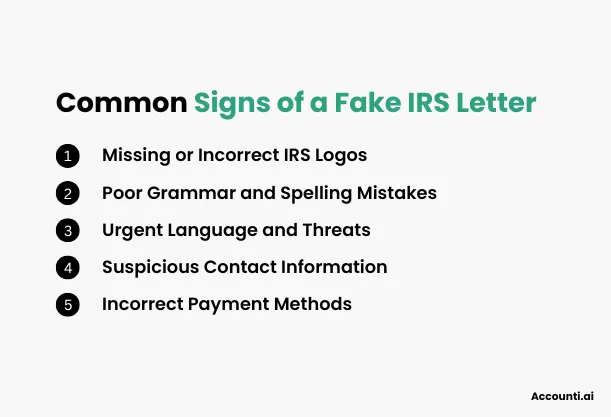
How to Spot a Fake IRS Letter & Avoid Scams | Key Warning Signs to Know
Tax scams are on the rise, and one of the most unsettling scams involves fake IRS letters. For many, the sight of an IRS letter is already enough to spark anxiety, but when scammers try to capitalize on this fear, it can turn into a nightmare. In this guide, we’ll dive deep into how to identify a fake IRS letter, ways to verify an IRS communication, and actionable steps to take if you come across a fraudulent message.
Why It’s Important to Identify Fake IRS Letters
Fake IRS letters have become increasingly sophisticated, often looking eerily similar to the real thing. Unfortunately, the consequences of falling victim to such a scam can be severe, ranging from identity theft to significant financial losses. By learning how to spot the warning signs of a fake IRS letter, you can protect yourself and your loved ones from falling into these dangerous traps.
Common Signs of a Fake IRS Letter
Understanding the typical red flags in a fake IRS letter is the first step to staying safe. Here are some of the most common elements that might signal that you’re dealing with a scam rather than legitimate IRS correspondence.

1. Missing or Incorrect IRS Logos
One of the first signs of a fake IRS letter is a poorly executed or missing logo. The IRS takes its branding seriously, and official documents almost always bear the official IRS emblem at the top. Look out for:
- Incorrect placement of the logo
- Low-quality or blurry printing
- Outdated or incorrect logos
A missing or misaligned logo is a significant red flag. Scammers may skip over the logo entirely or attempt to use an old version, making it stand out.
2. Poor Grammar and Spelling Mistakes
The IRS maintains high standards in all its communications, which means you’re unlikely to see glaring grammatical errors or misspelled words in a genuine IRS letter. If you notice odd phrasing, poor grammar, or simple typos, it's likely a scam. Look for:
- Strange wording that sounds non-native
- Misuse of common terms
- Unusual tone that doesn’t sound official
Scammers may not be native English speakers, so their wording might seem off, which is a telltale sign of a fake IRS letter.
3. Urgent Language and Threats
The IRS will never use intimidating language or threaten immediate consequences. They have a process in place to deal with unpaid taxes, and their letters are generally straightforward and matter-of-fact. If the letter is filled with high-pressure language, like “Act immediately!” or “Failure to comply will result in immediate legal action,” it’s likely a scam.
4. Suspicious Contact Information
The IRS has set communication channels, and they never ask for personal information through unverified sources. Be cautious if you see:
- Phone numbers that are not listed on the IRS website
- Requests for personal details (like your Social Security Number) in the letter
If the contact information seems off, don’t hesitate to verify it through the official IRS website.
5. Incorrect Payment Methods
Another major red flag is when the letter asks for payment through unconventional means. The IRS does not demand payments through:
- Gift cards
- Prepaid debit cards
- Direct wire transfers
A legitimate IRS letter will only ask for checks to be made payable to the “United States Treasury” and nothing else.
Comparison Between Real and Fake IRS Letters
To make it easier to distinguish between legitimate and fraudulent IRS letters, here’s a side-by-side comparison:
|
Feature |
Real IRS Letter |
Fake IRS Letter |
|
Logo |
Clear, high-quality, placed at the top |
Missing, blurry, or poorly placed |
|
Grammar & Spelling |
Professional, accurate |
Grammatical errors, typos |
|
Language |
Neutral, factual, no threats |
Urgent, threatening language |
|
Payment Requests |
Payable to “United States Treasury” |
Requests gift cards, wire transfers |
|
Contact Information |
Listed on IRS official website |
Often unverified, random phone numbers |
|
Requests for Personal Info |
Only asks if necessary and through official channels |
Often demands Social Security or bank details |
Referencing this table can serve as a quick check when evaluating any letter that claims to be from the IRS.
How to Verify an IRS Letter’s Authenticity
If you’re unsure about a letter’s authenticity, there are several reliable methods for verification.
1. Cross-Check with Official IRS Contact Information
One of the simplest ways to verify a letter is by cross-referencing the contact information on the letter with that on the IRS website. Legitimate IRS letters will use phone numbers and addresses that match those listed online. Never rely solely on the information in the letter without double-checking with official sources.
2. Use IRS Online Tools for Verification
The IRS offers several tools that you can use to check the status of your taxes or confirm if you have any pending obligations:
- Where’s My Refund?: Track the status of any refunds you’re expecting.
- Online Account: Review your tax account, including any outstanding amounts due.
- IRS Taxpayer Assistance Center (TAC): Locate a local IRS office for in-person assistance.
Using these tools can provide clarity on whether the IRS actually needs to contact you, helping to confirm or dismiss any suspicions.
3. Consult a Tax Professional
If you’re still uncertain, a tax professional can help review the letter and offer guidance. Tax professionals have experience with legitimate IRS communications and can identify anything unusual that might suggest a scam.
What To Do if You Receive a Suspicious IRS Letter
If you believe you’ve received a fake IRS letter, taking immediate action can protect you and prevent any possible identity theft or financial loss.
1. Report the Fake IRS Letter
You can report suspected fake IRS letters to the IRS directly by:
- Forwarding Scams to phishing@irs.gov: If the letter came via email or if you suspect an email scam, send it to this address.
- Calling the IRS at 1-800-366-4484: Use this number for reporting tax scams, as it connects you to the Treasury Inspector General for Tax Administration (TIGTA).
2. Safeguard Personal Information
If you provided any personal details in response to the fake letter, act quickly:
- Freeze Your Credit: Contact the credit bureaus (Experian, Equifax, and TransUnion) to place a credit freeze.
- Monitor Your Financial Accounts: Watch for any unusual activity in your bank and credit accounts.
- Change Passwords: For any accounts that may have been compromised.
By being proactive, you can limit the potential damage from identity theft.
3. Take Preventive Measures for the Future
Make sure to educate yourself and others in your household about common tax scams. Stay updated on IRS notices, and remember that legitimate IRS communications will always adhere to a formal, consistent process.
Important Resources for Spotting Fake IRS Letters
To stay on top of the latest tax scams, refer to these trusted resources:
- IRS Website (www.irs.gov): The official site offers the latest information on tax scams, guidelines for identifying fraud, and contact details.
- IRS Taxpayer Assistance Center (TAC): For in-person help, you can locate your nearest TAC for assistance in verifying letters or addressing other IRS-related issues.
- Federal Trade Commission (FTC) - www.consumer.ftc.gov: The FTC website has helpful resources on identity theft and scam prevention.
Bookmarking these resources can be beneficial, especially if you receive another suspicious communication in the future.
Conclusion
In an age where scammers are constantly refining their tactics, staying vigilant against tax scams is essential. By learning how to spot a fake IRS letter, cross-checking details, and knowing who to contact if you’re in doubt, you can safeguard yourself from these scams. Remember, the IRS will never threaten you or ask for payment through unconventional methods. Keep calm, verify any questionable letter, and take the right steps to protect your information.
FAQs
1. What Should I Do if I Think I Paid a Scammer?
If you suspect that you’ve already paid money to a scammer, contact your bank or credit card company immediately to report the fraud. Additionally, you may want to file a report with the Federal Trade Commission (FTC) at www.ftc.gov.
2. Will the IRS Ever Contact Me Through Email or Phone?
The IRS rarely initiates contact via email or phone calls. Instead, they typically use postal mail. If you receive an email or call claiming to be from the IRS, it’s best to report it as a possible scam.
3. Can the IRS Demand Immediate Payment?
No, the IRS follows a formal process for tax collection. They will never demand immediate payment or threaten to arrest you for unpaid taxes without giving you the chance to review and address the issue.
4. How Can I Tell if the IRS Letter I Received is Real?
Examine the letter closely for signs such as the official IRS logo, correct contact information, and proper grammar. Additionally, you can verify any IRS communication by contacting the IRS directly.
5. Are Fake IRS Letters a Seasonal Scam?
While tax scams can happen anytime, they often spike around tax season when individuals are expecting communications from the IRS. Staying aware year-round, however, is key to protecting your information.

 Rohit Kapoor
Rohit Kapoor

